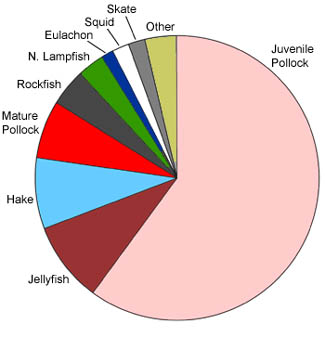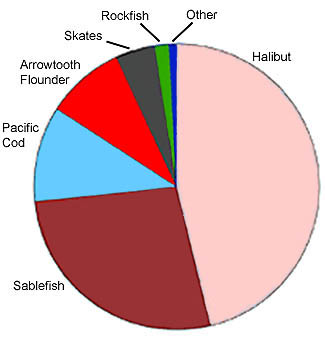| |

Figure 2. Percentage of prey species caught in the September 2003
hydroacoustics/trawl surveys.
|
|
Steller Sea Lion Prey Study
As part of ongoing research to assess Steller sea lion (Eumetopias jubatus)
prey, hydroacoustic cruises were conducted in Lynn Canal and Frederick
Sound, Alaska, during September 2003 aboard the chartered fishing vessel
Viking Storm. Hydroacoustic (echosounding) transects in open water and
bays were coupled with trawl catches to verify hydroacoustic assessment
of fish species.
The majority of the 3,122 kg of fish caught were juvenile walleye pollock
(Theragra chalcogramma), followed by Pacific hake (Merluccius productus),
jellyfish, mature walleye pollock, northern lampfish (Stenobrachius leucopsarus),
rockfish (Sebastes spp.), and eulachon (Thaleichthys pacificus) (Fig. 2).
Relative to previous cruises, jellyfish and squid were more abundant. Mature
pollock were less abundant than previously observed and were seemingly
replaced by hake, particularly in the open water. Species never before
encountered in the hydroacoustic cruises were caught in both study areas,
including a relatively large species of myctophid in Lynn Canal preliminarily
identified as pinpoint lampfish (Nannobrachium regale). In Frederick Sound,
newly encountered species included big skates (Raja binoculata), longnose
skates (R. rhina), spotted ratfish (Hydrolagus colliei), Pacific halibut
(Hippoglossus stenolepis), sablefish (Anoplopomus fimbria), an Okhotsk
snailfish (Liparus ochotensis; preliminary identification), and redbanded
rockfish (Sebastes babcocki).
|

Figure 3. Percentage of prey species caught in the September longline survey.
|
|
A total of 229 walleye pollock, Pacific herring (Clupea pallasi), eulachon,
capelin (Mallotus villosus), and Pacific hake were collected for nutritional
analysis with particular emphasis on demersal samples. Samples of Steller
sea lion scat were collected from each of the three haulouts visited (Sunset
Island, Brothers Island, and Sail Island). Of the branded animals observed
during the scat collections, 18 were photographed. Independent analysis
of the photographed brands will be combined with the field observations
to improve brand accuracy.
In addition to the hydroacoustic survey, the first longline cruise to examine
benthic prey species was completed in Frederick Sound during September
2003 aboard the chartered fishing vessel Antares. Nearly half of the 6,000
kg of catch was Pacific halibut, followed by sablefish, Pacific cod (Gadus
macrocephalus), arrowtooth flounder (Atheresthes stomias), skates, and
rockfish (Fig. 3 above). Species caught in quantities less than 1% of the catch
by mass included Pacific sleeper sharks (Somniosus pacificus), walleye
pollock, Dover sole (Microstomus pacificus), spiny dogfish (Squalus
acanthius), and spotted ratfish.
By Johanna Vollenweider and Mike Sigler.
2003 Sablefish Longline Survey Completed
The Alaska Fisheries Science Center (AFSC) has conducted an annual longline
survey of sablefish and other groundfish in Alaska from 1987 to 2003. The
survey is a joint effort involving two AFSC research divisions: the Auke
Bay Laboratory and Resource Assessment and Conservation Engineering Division.
The survey replicates as closely as practical the Japan-U.S. cooperative
longline survey conducted from 1978 to 1994 and also samples gullies not
sampled during the cooperative longline survey. In 2003, the twenty-fifth
annual longline survey of the upper continental slope of the Gulf of Alaska
and the eastern Bering Sea was conducted. One hundred fifty-two longline
hauls (sets) were completed between 1 June and 1 September 2003 by the
chartered fishing vessel Ocean Prowler. Sixteen kilometers of groundline
were set each day, containing 7,200 hooks baited with squid.
Sablefish was the most frequently caught species, followed by giant grenadier
(Albatrossia pectoralis), Pacific cod, and shortspine thornyhead (Sebastolobus
alascanus). A total of 87,141 sablefish were caught during the survey;
4,055 sablefish, 535 shortspine thornyhead, and 100 Greenland turbot (Reinhardtius
hippoglossoides) were tagged and released during the survey. Electronic
temperature-depth tags were surgically implanted in 45 Greenland turbot
and 55 shortspine thornyheads. This is the first time these species have
been tagged with electronic tags. Length-weight data and otoliths were
collected from approximately 2,300 sablefish. Killer whales (Orcinus orca)
took fish from the longline at seven stations in the Bering Sea and three
stations in the western Gulf of Alaska. These numbers are slightly higher
than in previous years. Sperm whales (Physeter macrocephalus) were common
near the vessel in the eastern gulf and the west Yakutat region and were
observed taking fish from the line at several stations, similar to previous
years.
Several special projects were conducted during the 2003 longline survey.
Coral caught on the line were collected for identification and sample preservation;
several specimens of exceptionally rare black coral (Antipatharia sp.)
were collected. A seabird occurrence study was conducted for the second
year -- the study is being conducted during several different surveys to address
where and when certain seabird species occur in Alaska waters. In addition,
the Alaska Department of Environmental Conservation is conducting a monitoring
project for environmental contaminants in Alaskan fish. Fifty specimens
of sablefish caught on the longline survey were collected throughout the
Gulf of Alaska and the Bering Sea and sent to the department for contaminants
analysis.
By Chris Lunsford.
>>>continued
 |
 |
quarterly July-Sept 2003 sidebar
AFSC Quarterly
Research Reports
July-Sept 2003
Contents
Feature
Auke Bay Lab
National Marine
Mammal Lab
RACE Division
REFM Division
Quarterly Index
Quarterly Home
|

